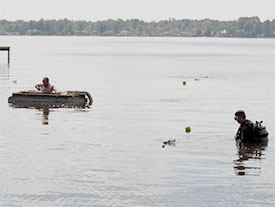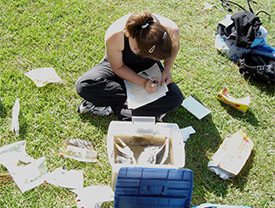ECU's 2006 Fall Field School
Project Journal
21 September 2006
By Joe Hoyt

Today when we first arrived on sight I was met with disappointment. Yesterday I had placed some meat from Adam’s bologna sandwich in a crab pot adjacent to the dock in hopes of capturing a few delicious crustaceans. Upon inspection I found that not only were no crabs captured, but the shred of meat was completely unaltered after a night spent soaking in the Pamlico River. Adam’s lunch-meat is clearly as chemical-laden as Site-A.

While Joe sifts through the dredge spoil, Dr. Stewart oversees installation of the baseline.
Today it seems things are really coming together. With clear tasks established throughout the day we were able to work efficiently. In the morning Amy and I completed shoreline survey. We only needed to record a few points at the end of the remnant pier, which required the use of the boat and Dr. Stewart’s amazing lasso ability to secure ourselves to some old pilings.

The crew work with peace of mind--knowing that Dive Safety Officer, Mark Keusenkothen, is watching over them..
Following this, the team began preparing for the rest of the days tasks. Establishing the baseline now that the port side was cleared of overburden was of primary importance. This will allow buddy teams to begin documenting the port side, while dredging continues on the starboard section. Dredging the starboard side of course was the other primary task. Students not assisting with these two primary objectives completed several other tasks such as, artifact bagging/tagging, cross-line creation, or photographic documentation of the project.

Amy recording and bagging material culture that was unintentionally dredged off the vessel.
By the end of the day the baseline, as well as many cross-lines (these are used to mark individual mapping sections, which is helpful in zero-visibility), had been established. All of the artifacts collected from the dredge spoil had been bagged, tagged and placed in a water-filled container (most of these items are either fasteners or tiny loose timbers). The dredging is not yet completed but there was considerable progress. The starboard side is under much greater sand coverage which makes clearing it slow but allows for a higher degree of preservation. One of the timbers I uncovered today still showed a considerable amount of white paint. Hopefully the paint doesn’t contain lead, and dredging operations can continue.
For more information you can visit the ECU website at:
http://www.ecu.edu/maritime/index.htm
Return to Project Journal home page.

